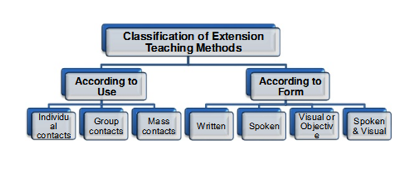Extension is an educational process for bringing about the maximum number of desirable changes among the people, which involves both learning, & teaching and needs some tools or methods commonly known as extension-teaching methods. It is, therefore, necessary here to understand what is meant by learning, teaching & extension methods.
'Learning' is the process by which an individual, through his own activity, attains a change in his behaviour. It is an active process on the part of the learner. The essential role of an extension worker is to create effective 'learning situations'. An effective learning situation requires the following essential elements:
- An instructor (an extension worker, e.g. an extension officer or a village-level worker).
- Learners (the farmers, the farm women & the youth).
- Subject-matter (the recommended improved practices, such as the seeds of high-yielding varieties,fertilisers, balanced diet, etc.)
- Teaching material, such as a flannel-board, a black-board, charts, models, samples, slides, film strips, etc.
- Physical facilities, such as sitting accomodation, good visibility, etc.
The extension worker should skillfully manipulate the elements of the learning situation & provide satisfactory learning experiences for the people. The farmer, the farmer women or the farm youth are the focal points in the learning situation. The main aim of an extension worker is to bring about a change in this behaviour of the people with the help of a judicious combination & use of different elements. all the teaching should be carried out according to the needs & resources of the local community or group.
'Teaching' is the process of arranging situations in which the things to be learnt are brought to the notice of the learners, their interest is developed & desire aroused, i.e. they are stimulated to action.for example, if we want to teach the farmers the use & advantages of chemical fertilisers, we do this by conducting demonstrations on their fields, showing them how the fertilisers are applied, & compare the yield of the fertilised crop with that of the crop to which no fertilisers has ben applied. After seeing the beneficial effect of a fertilisers, the farmer is convinced & motivated to action & starts using fertilisers regularly.
Extension-teaching methods
The extension-teaching methods are the tools & techniques used to create situations in which communication can take place between the rural people & the extension workers. They are the methods of extending new knowledge & skills to the rural people by drawing their attention towards them, arousing their interest & helping them to have a sucessful experience of the new practice. A proper understanding of these methods & their selection for a particular type of work are necessary.
Classification of extension teaching methods

One way of classifying the extension methods is according to their use & nature of contact. In other words, whether they are used for contacting people individually, in groups or in masses. Based upon the nature of contact, they are divided into individual, group & mass-contact methods.
Individual-contact methods. Extension methods under this category provide opportunities for face-to-face or person-to-person contact between the rural people & the extension workers. These methods are very effective in teaching new skills & creating goodwill between farmers & the extension workers.
Group-contact methods. Under this category, the rural people or farmers are contacted in a group which usually consists of 20 to 25 persons. These groups are usually formed around a common interest. These methods also involve a face-to-face contact with the people & provide an opportunity for the exchange of ideas, for discussions on problems & technical recommendations & finally for deciding the future course of action.
Mass or community-contact methods. An extension worker has to approach a large number of people for disseminating a new informaton & helping them to use it. this can be done through mass-contact methods conveniently. These methods are more useful for making people aware of the new agricultural technology quickly. Important extension-teaching methods under these 3 categories are listed in the following chart.
Chart 1. Classification of extension-teaching methods according to their use |
||
| Individual contacts |
Group contacts |
Mass contacts |
|---|---|---|
Farm & home visits |
Method demonstration & result demonstration |
Bulletins |
Office calls |
National demonstration leader-training meetings |
Leaflets |
Telephone calls |
Conferences & discussion meetings & workshops |
Circular letters & radio |
Personal letters |
Field trips |
Television,exhibitions,fairs,posters |
2. According To Form : Extension-teaching methods are also classified according to their forms, such as written, spoken & audio-visual. Some of the important methods under each of these 3 categories are given in Chart 2.
Chart 2. Classification of extension-teaching methods according to their form |
||
Written |
Spoken |
Objective or visual |
|---|---|---|
Bulletins |
General & special meetings |
Result demonstration |
Leaflets,folders,News articles |
Farm & home visits |
Demonstration posters |
Personal letters |
Official calls |
Motion-picture or movies, charts |
Circular letters |
Telephone calls, radio |
Slides & film-strips,models,exhibits |

